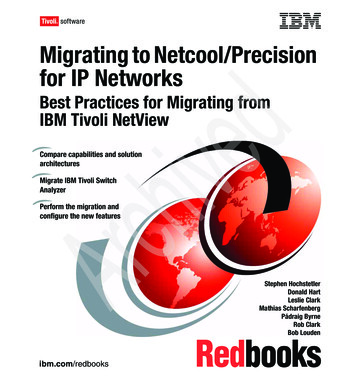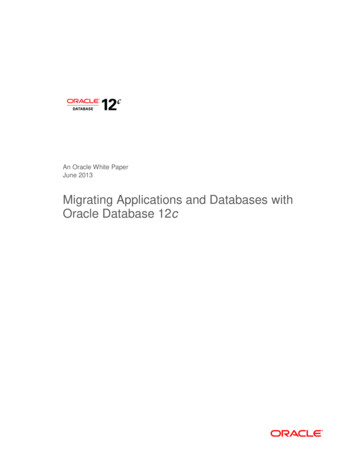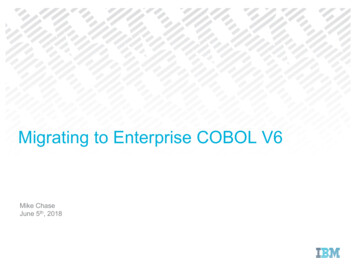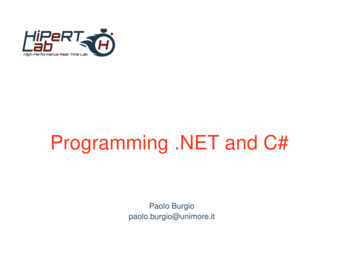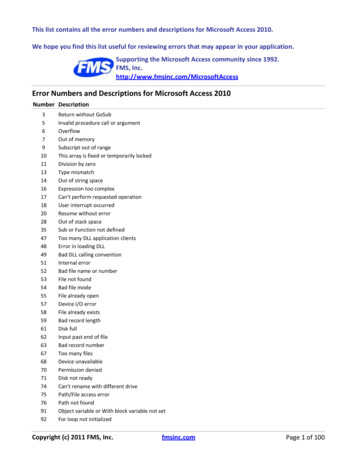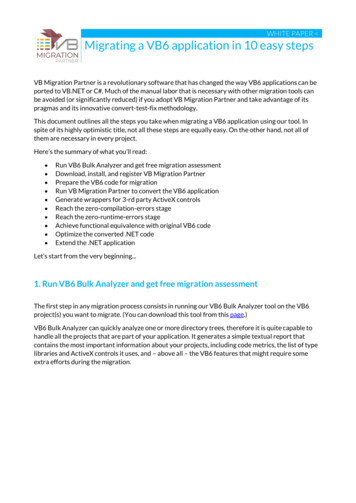
Transcription
WHITE PAPER Migrating a VB6 application in 10 easy stepsVB Migration Partner is a revolutionary software that has changed the way VB6 applications can beported to VB.NET or C#. Much of the manual labor that is necessary with other migration tools canbe avoided (or significantly reduced) if you adopt VB Migration Partner and take advantage of itspragmas and its innovative convert-test-fix methodology.This document outlines all the steps you take when migrating a VB6 application using our tool. Inspite of its highly optimistic title, not all these steps are equally easy. On the other hand, not all ofthem are necessary in every project.Here’s the summary of what you’ll read: Run VB6 Bulk Analyzer and get free migration assessmentDownload, install, and register VB Migration PartnerPrepare the VB6 code for migrationRun VB Migration Partner to convert the VB6 applicationGenerate wrappers for 3-rd party ActiveX controlsReach the zero-compilation-errors stageReach the zero-runtime-errors stageAchieve functional equivalence with original VB6 codeOptimize the converted .NET codeExtend the .NET applicationLet’s start from the very beginning.1. Run VB6 Bulk Analyzer and get free migration assessmentThe first step in any migration process consists in running our VB6 Bulk Analyzer tool on the VB6project(s) you want to migrate. (You can download this tool from this page.)VB6 Bulk Analyzer can quickly analyze one or more directory trees, therefore it is quite capable tohandle all the projects that are part of your application. It generates a simple textual report thatcontains the most important information about your projects, including code metrics, the list of typelibraries and ActiveX controls it uses, and – above all – the VB6 features that might require someextra efforts during the migration.
WHITE PAPER Migrating a VB6 application in 10 easy stepsVB6 Bulk Analyzer is a command-line tool that must be run from a prompt window. You can copy it tothe root folder of the directory tree that contains your source code, type VB6Analyzer, and press theEnter key. The tool supports a few additional options, but you rarely need them. (You can list theseoption by adding the /help option on the command line.).If your VB6 codebase is spread in different folders, it is essential that you specify all source codefolders on the command line, to create a consolidated report:VB6Analyzer c:\myapp\folder1 c:\myapp\folder2 c:\myapp\folder3In all cases, the utility creates a report file named VBAnalyzer Report.txt in the current directory.The contents of this file should be enough self-explanatory, but you don’t need to interpret ityourself. Instead, go to our Write Us page, fill a few fields with your name and email, and use thededicated field to upload the report file.We typically analyze the report as soon as we receive it, of course if our office is open when you sendit. (Please account for time zone difference we live at G.M.T. 1.) We typically reply in a few hours,even though complex reports might take longer.In return for your report you will receive a very detailed textual assessment of your VB6 application,with tips on how to leverage VB Migration Partner for a smooth migration experience. If a given issuehas multiple solutions, the assessment document explains the pros and cons of each option. Forexample, the assessment often includes recommendations on the best way to migrate your ActiveXcontrols and your database-intensive code, among the other things.The mail from Code Architects usually contains also information about the VB Migration Partnerlicense that is most appropriate for your needs. For more information about our license terms, readthe FAQ section and download the End User License Agreement (EULA).You can purchase the product or just apply for a temporary Trial License. VB Migration Partner TrialEdition is identical to the Full edition except for four details: it expires in 14 days
WHITE PAPER Migrating a VB6 application in 10 easy steps migrations require an active Internet connectiona few pragmas have been disabledthe VB.NET or C# code that it generates can’t be expanded with new forms and classesNotice that users of the Trial Edition enjoy the same degree of support that regular users do,therefore it is an opportunity to test how good and reactive our tech support is.2. Download, install, and register VB Migration PartnerThis is surely the simplest step in the entire process.Regardless of whether you purchased the commercial edition of VB Migration Partner or are justtesting the Trial Edition, you will receive a download URL. Follow the link, download the file, unzip it,and run the setup procedure.The first time you run VB Migration Partner you’ll have to register your copy. This procedure is fullyautomated and runs as soon as you attempt your first migration. In some rare cases – for example, ifyour firewall is very picky about which packets can run over the network – the automated procedurefails and you’ll have to perform a manual registration.
WHITE PAPER Migrating a VB6 application in 10 easy stepsEach time you launch it, VB Migration Partner checks whether a new version is available and asks youwhether you want to download it. We recommend that you always run the most recent build that isavailable on our servers.Before using VB Migration Partner you should have a quick read at its manual, with a keen eye on thesection related to migration pragmas. If you master pragmas you can make VB Migration Partner dowhatever you want, therefore the time you devote to studying them won’t be wasted.Also, we recommend that you give at least a quick look at our knowledge base. Don’t read each andevery article, just a quick read of their titles should be enough to ring a bell in your brain if and whenyou bump into a migration issue that we know how to solve.3. Prepare the VB6 code for migrationVB Migration Partner is capable to deal with virtually the entire set of documented VB6 features,therefore this step is seldom required, and you can often migrate your VB6 code without having toprepare it in any way. (In this respect, VB Migration Partner is much more powerful than any otherVB conversion tool on the market.)
WHITE PAPER Migrating a VB6 application in 10 easy stepsThe reasons why you might need to edit the VB6 code before attempting the migration are pointedout in the assessment document you receive from the VB Migration Partner team. Here are a fewVB6 features that may require some care in this stage.Windows API wrappingVB Migration Partner supports all VB6 features related to Declare statements – for example, As Anyand callback parameters are virtually always translated correctly.However, some calls to Windows API or other external DLLs might use the undocumented VarPtr,StrPtr, and ObjPtr methods. These VB6 methods aren’t supported under VB.NET/C# and there is noautomated way to migrate them. The report that VB6 Bulk Analyzer generates highlights whetheryour application uses these keywords. If it does, you should use the Find command in the VB6 IDE tolocate each one of them and see whether you can remove individual occurrences.
WHITE PAPER Migrating a VB6 application in 10 easy stepsIn many cases you can prepare your Declare-intensive VB6 code for migration by wrapping all callsinside methods. For a detailed discussion of this technique, please read the whitepaper “Tips forsmooth migration of Windows API calls”.ActiveX EXE projectsThe .NET Framework doesn’t support anything that can be considered as equivalent to ActiveX EXEs.VB Migration Partner allows you to choose whether the project should be converted into a standardEXE project or a .NET DLL, therefore you must decide what is most appropriate in each specific case.There can be several reasons why a VB6 project had to be compiled as an ActiveX EXE. One of themost common was that you needed a stand-alone executable that could also expose objects to theoutside, for example an order processing application that exposes an object model for other apps (orplug-ins) to access and manipulate the data using a simplified and consistent interface. In such cases,you can solve elegantly your migration problems by splitting the ActiveX EXE project in two parts: anActiveX DLL project that exposes the object model and a standard EXE project that shows the userinterface and references the DLL.4. Run VB Migration Partner to convert the VB6 applicationIt’s now time for the first run through VB Migration Partner. If you have a project group (a .vbg file)that gathers all the VB6 projects of your app, load it in VB Migration Partner. If you have separate.vbp projects, consider whether you should create a .vbg file for the only purpose of migrating them inone single operation. In general, migrating multiple projects in one step delivers better results,because VB Migration Partner can generate better code for inter-project calls. However, if you needto convert more than three or four projects, converting them separately allows you to reduce thenumber of compilation and runtime errors and have a working .NET project sooner.
WHITE PAPER Migrating a VB6 application in 10 easy stepsWhen loading the project, VB Migration Partner checks that the EXE or DLL executable file is foundand its creation date is earlier than all the source files in the project. If this isn’t the case, the followingmessage appears when loading the project:
WHITE PAPER Migrating a VB6 application in 10 easy stepsVB Migration performs this test because it guarantees that the VB6 source code is syntacticallycorrect and has compiled without errors. If you are sure that all post-compilation changes are OK andhaven’t introduced any syntax error, just press OK and continue. If you don’t want to be bothered bythis message in the future, you can disable the test by selecting the “Omit warning if VB6 executableis missing or outdated” option in the General tab of the Tools-Options dialog box.Once the project is successfully loaded, you should select the target language (VB.NET or C#) and thetarget version of Visual Studio and .NET Framework, in the Save tab of the Tools-Options dialog box.
WHITE PAPER Migrating a VB6 application in 10 easy stepsFinally you can convert to .NET by either selecting the Built-Convert to .NET command, or clicking onthe magic wand icon, or typing the F5 shortcut key. At the end of the conversion process, VBMigration Partner generates as many as six different kind of reports. Each of these reports can beused for a different purpose:Activity Log – VB Migration Partner emits several messages in this window during the migrationprocess. You should check these messages to ensure that all went well, that all type libraries andActiveX controls were found, that no unrecognized syntax forms where found, etc. If an errormessage is found in this window, odds are that you tried to convert a VB6 project that can’t compile,you didn’t installed all COM type libraries correctly, or you run VB Migration Partner on a computerdifferent from the computer where you compiled the VB6 project.
WHITE PAPER Migrating a VB6 application in 10 easy stepsMigration Results – This window displays all migration warnings and errors. The presence of awarning or error doesn’t necessarily indicate that the conversion has failed; it only means that youhave to pay close attention to the specified portions of the VB.NET ot C# code and ensure that theyconverted correctly.You can also get a summary of all migration results – with all issues and warnings in a given project orfile – grouped by their type – by clicking on the Warnings tab in the right pane.Compilation Results – You can use the Compile command in the Build menu to have VB MigrationPartner run the vbc.exe compiler behind the scenes, gather its output, and display all messages in the
WHITE PAPER Migrating a VB6 application in 10 easy stepsbottom pane. If you are lucky and your VB6 code isn’t too complex, you’ll see just very few errors inthis window. (Our statistics show that .NET apps generated by VB Migration Partner have onecompilation error for about 1,000 executable statements on the average.)If you are very lucky, this window will display no error messages and the VB.NET or C# code is readyto compile and run. It doesn’t happen often, though, but it happens.If there are many compilation errors, don’t feel discouraged. Most of these errors are likely to havethe same cause. They will go away after adding a few well-chosen pragmas.Also, notice that the earlier Visual Basic .NET compilers have a limit of 102 error messages, afterwhich the compilation is aborted, therefore you will never see more than 102 errors. This means thatyou still see 102 errors even after fixing some of them, because you then see errors that weren’tvisible before. A similar thing happens with the C# compiler: when you fix some compilation errors,the C# parser can proceed in analyzing the source code and may find new compilation errors that itdidn’t display initially.Code Metrics – the Metrics tab in the right pane displays stats about the project or file selected inthe tree view on the left. This information can be useful for a number of purposes. For example, youmay sort projects and files on their size, so that you can start with the simplest project or you canassign each project to a different people in your team.
WHITE PAPER Migrating a VB6 application in 10 easy stepsOne of the most important values in the table is the Cyclomatic index, which measures all the possibleexecution paths inside a method. For example, a method that contains only an If block has a CI equalto 2; if the Else block contains a Select Case block with five Case sections, then the method’s CI isequal to 6, and so forth. The CI is important in migration scenarios because it represents theapproximate number of tests you should perform to ensure that the .NET code behaves exactly likethe original VB6 code. By sorting all methods in a file on their CI you can quickly see which methodsare more complex and should be give more attention during the test and QA phase.The Metrics tab also show how many “problematic” VB6 items are in a given project or file, includingVariant variables, Gosub keywords, On Error statements, auto-instancing (As New) variables, arrayswith non-zero lower bounds, and so forth. High values for these counters are indicators that youmight need to pay more attention to the corresponding classes and methods.Migration message explanation – If you are new to migrations from VB6, odds are that manymigration errors and warnings will look a bit obscure. Or maybe you understand what a messagemeans and still have no cue on how to fix it. In such cases, you can use the Explain Errors and Warningscommand in the Tools menu to produce a detailed explanation of each migration message and adescription of available workarounds.Notice that this report is created on Code Architects’ Web server, therefore it requires a workingInternet connection. Only the ID and the number of occurrences of each warning are sent to ourserver; no information about your application ever leaves your computer.
WHITE PAPER Migrating a VB6 application in 10 easy stepsAssessment report - You can generate a Microsoft Excel worksheet containing a very detailed reportof all the migration errors and warnings, together with an estimation of the time required to fix them,get a fully working .NET application, and complete the migration process. The report also contains anestimation of costs, which are evaluated by multiplying the time required for the hourly wage of thepeople in your team. The report accounts for five professional roles: junior and senior developer, test,architect, and product manager.All values in the spreadsheet can be customized and you can even provide a custom template if youwish, in the Reports tab of the Tools-Options dialog box.
WHITE PAPER Migrating a VB6 application in 10 easy stepsBefore you produce your first assessment report, a word of caution is in order. All time/costestimations are based on the assumption that each warning/error must be fixed singularly. Thisassumption always brings to very high numbers, and therefore to a very expensive migration.For example, if the original VB6 code contains many Variant variables, odds are that the .NET codewill contains hundreds of warnings #0354 (“Unable to read default member of symbol 'XYZ'.Consider using the GetDefaultMember6 helper method.”). According to the standard Excel template,it takes 1 minute from a junior developer and 1 minute for a tester to fix this warning, which meansthat even a simple VB6 project might require many hours just to get rid of this warning.In practice, however, you often need only a project-level pragma to avoid a whole set of warnings ofsame type. In this specific example, the following pragma makes VB Migration Partner generate a callto GetDefaultMember6 helper method, which nicely solves the problem and prevents the generationof #0354 warnings:'## project:DefaultMemberSupport TrueThe bottom line is, be aware that cost/time evaluations you read in assessment reports are oftenover-estimated and should be taken with a grain of salt.5. Generate wrappers for 3-rd party ActiveX controls
WHITE PAPER Migrating a VB6 application in 10 easy stepsThis step is necessary only if your project uses one or more ActiveX controls that aren’t in VB6toolbox. For such ActiveX controls it is necessary that you generate and compile a wrapper class, aprocess that requires the following actions:1. Run the AxWrapperGen utility to generate the code for the wrapper class. The utilitygenerates a single .NET class library project that contains one wrapper class for each controlcontained in an .ocx file.2. Load the generated .NET project in Visual Studio, read the instructions at the top of eachwrapper class, and edit the code accordingly.3. Compile the project and deploy the resulting DLL in VB Migration Partner’s install folder.Editing the wrapper class is necessary only for complex ActiveX controls, such as grids. In most othercases, the code that AxWrapperGen generates compiles correctly at the first attempt.Notice that these operations are optional, in the sense that you might prefer to immediately skip tonext step, without having prepared any ActiveX control wrapper. In this case you’ll end up with oneor more red rectangles on your VB.NET forms, each one working as a placeholder for anunrecognized ActiveX control. The decision of not converting ActiveX controls with AxWrapperGencan be convenient in some cases, for example if the ActiveX control is used only a few times in theentire project and you plan to replace it with a native .NET control anyway when the migration iscompleted.6. Reach the zero-compilation-errors stageIn this step you get rid of all the compilation errors in your VB.NET or C# code, so that you can finallylaunch it.If VB Migration Partner were a “traditional” conversion tool – like the Upgrade Wizard or any otherconversion software on the market – you’d need to fix each and every compilation error in the .NETcode. In other words, you wouldn’t run the conversion tool any longer and just work on a “snapshot”of the converted code.Fortunately for you, VB Migration Partner is not a traditional conversion tool. Rather, it’s asophisticated piece of software that accompanies you during all the phases in your migrationinitiative, from the initial planning to the test stage. The key of VB Migration Partner’s power is theso-called convert-test-fix methodology.In a nutshell, the convert-test-fix methodology boils down to the following, simple statement: never,ever manually modify the converted .NET code. Instead, you apply one or more pragmas to the originalVB6 code and re-run the migration. The great thing about pragmas is that you can apply them to thesolution-, project-, file-, method- and variable-level. Quite often a few project-level pragmas caneliminate all compilation errors – or at least the large majority of them.Basically, there are three ways for adding pragmas:
WHITE PAPER Migrating a VB6 application in 10 easy steps1. type the pragma in the VB6 editor, save the file, then switch to VB Migration Partner, reloadthe project (using the Reload command in the File menu), and re-run the migration.2. use VB Migration Partner’s integrated code editor to insert the pragma in the original VB6code, save, and re-run the migration.3. (for project-level pragmas only) use Notepad or another text editor to enter the pragma in a*.pragmas file in the same folder as the .vbp file, then reload the project using the Reloadcommand in the File menu, and re-run the migration.You can use the Insert Pragma command (in Edit menu) to have VB Migration Partner help you inselecting the right pragma for a specific purpose. In scenario A, use the Copy button and then pastethe code right in the VB6 editor. In scenario B, click on the OK button to insert the code in VBMigration Partner’s integrated editor.To reach the zero-compilation-error stage as quickly as possible, it is essential that you becomefamiliar with the many pragmas that VB Migration Partner. Our online documentation provides manydetails about pragmas, therefore it makes little sense to rehash all that information in this article.However, our experience is that the following pragmas are most useful in this phase of the migration:ImportTypeLib is useful if VB Migration Partner fails to correctly recognize a type library.
WHITE PAPER Migrating a VB6 application in 10 easy stepsSetName allows you to assign a different name to a variable or member, in case the original VB6name clashes with a VB.NET, C# or .NET Framework member.ArrayBounds and ShiftIndexes can fix problems with arrays having nonzero lower index.ArrayRank can be necessary if VB Migration Partner hasn’t enough information to infer the numberof dimensions of an array.PreProcess and PostProcess allow you to tweak the original VB6 code or the generated .NET code,respectively, to get rid of various errors. (Our Knowledge Base contains many examples of how thesepragmas can be useful.)MergeInitialization can be necessary if VB Migration Partner fails to correctly merge a variable withthe first assignment to it.ClassRenderMode should be used if you are migrating a public classed used as an interface, but VBMigration Partner can’t generate the correct interface because the current ActiveX DLL projectdoesn’t include an Implements statement that references the interface.If you are converting to C#, you may find the following pragmas very useful to reach the zerocompilation-error stage:UseDynamic generates dynamic variables that support late-bound calls, rather than cumbersomecalls to the VB6Helpers.Invoke method.CSharpOption OverloadsForByval generates method overloads that contain by-value parametersinstead of ref parameters, which in turn reduces the need to generate temporary variables wheninvoking thos methods.CSharpOption ExplicitInterfaceImplementation can help you implement an interface without namecollisions.CSharpOption ConvertOnErrorResumeNext generates lambda methods for each statement underthe scope of an On Error Resume Next statement.CSharpOption UseOut attempts to use out parameters instead of ref parameters, which in turn cansimplify the code that invokes the method.Even if the following pragmas don’t directly reduce the number of compilation errors, it’s a good ideato include them in the early migration attempts, so that you can test the behavior of code that is moresimilar to its final form:DeclareImplicitVariables is useful for modules that lack an Option Explicit statement.ConvertGosubs attempts to convert Gosubs into calls to separated methods.MergeIfs refactors nested IFs into a single IF that uses the AndAlso operator.Once again, the compile-test-fix methodology is an iterative process: you add one or more pragmas,convert to .NET and then compile the project (or load it into Visual Studio) to have a look at allcompilation errors.
WHITE PAPER Migrating a VB6 application in 10 easy stepsHere’s a simple tip that might significantly reduce your efforts to reach the zero-compilation-errorstage: look for the following migration warnings in the generated .NET code:#0501: Member isn’t used anywhere in current application.#0511: Member is referenced only by members that haven’t found to be used in current application.#0521: Unreachable code detectedThese messages typically mark portions of VB.NET or C# code that will be never executed and thatshould be dropped during the migration process. In general, you’ll take care of this code during theoptimization step, but if the code contains one or more portions that are never used yet contain manycompilation errors, it might make sense to drop those portions now. Instead of deleting the code inthe original VB6 code, you can use the RemoveUnusedMembers and RemoveUnreachableCodepragmas with the Remarks argument, so that the code will be temporarily commented until you cometo a final decision about whether you should really delete it.7. Reach the zero-runtime-errors stageIf the .NET code has no compilation errors, you can run it inside Visual Studio and check that itbehaves as expected and that no unexpected errors occur at runtime.As for previous step, you should abide by the convert-test-fix methodology and refrain frommanually editing the VB.NET or C# code. Instead, when you find an unexpected or unwanted runtimebehavior you should insert or more pragmas in the original VB6 code and then run VB MigrationPartner once again.The pragmas that are most likely to be useful to complete this stage are:DefaultMemberSupport allows to infer a variable’s default member at runtime and is useful withObject variables and with Variant variables that contain an object reference.
WHITE PAPER Migrating a VB6 application in 10 easy stepsInsertStatement, ReplaceStatement, ParseReplace, PreInclude and PostInclude insert or replaceVB.NET or C# code in the generated project.AutoNew ensures that an auto-instancing (As New) variable preserves its semantics in .NET.UseSystemString should be used with all Type End Type structures that are passed to Declaremethods.NullSupport should be used for Variant expressions that deal with Null values.AddDataFile copies one or more data files into the .NET project folder and avoids “File not found”errors.WrapDeclareWithCallbacks is used to prevent the “orphaned delegate” problem that may occurwhen calling a Declare method that takes a delegate object (the AddressOf keyword).The following pragmas are only useful if you are converting to C#:CSharpOption ConvertOnErrorGoto forces the generation of try-catch block, even if they aren’t fullyequivalent to the original VB6 code. (it’s your responsibility checking that the difference doesn’tnegatively impact on the way C# code behaves.)CSharpOption AssumeConcatenation affects the way VB Migration Partner interprets the “ ”symbol when used with Variant or Object variables.CSharpOption AssumeStringComparison affects the way VB Migration Partner interpretscomparison operators when used with Variant or Object variables.Not all the runtime errors can be avoided or fixed by means of the above pragmas, though. Thecauses for unexpected errors can be just too many, but fortunately the VB Migration Partner’ssupport library automatically prevents most of these problems. All the known problems that thesupport library doesn’t handle automatically are documented in our Knowledge Base.A common problem that you solve in this step is Null values. VB6 and VB.NET/C# greatly differ inhow Null values are handled. In VB6 you can pass a Null value to most string functions, including Left,Mid, and Len (but not Left or Mid ), in which case the function returns Null. The .NET equivalent forNull is DBNull.Value, except you get an exception if you pass this value to any string function.Typically you solve this issue by a combination of the NullSupport and ReplaceStatement pragmas.Keep in mind that unsupported methods and properties don’t cause a runtime exception, by default.This behavior is intentional, because it allows you to run and test the .NET code, even if with reducedfunctionality. However, after completing the first set of tests, you might want to change the behaviorby adding the following line of code in the .NET project:' VB.NETVB6Config.ThrowOnUnsupportedMembers True// C#VB6Config.ThrowOnUnsupportedMembers true;
WHITE PAPER Migrating a VB6 application in 10 easy stepsInterestingly, VB Migration Partner’s support library provides the ability to automatically generate alog for any fatal exception, which you enable as follows:' VB.NETVB6Config.LogFatalErrors True// C#VB6Config.LogFatalErrors true;8. Achieve functional equivalence with original VB6 codeAfter you successfully run the .NET project without any unexpected exception you can focus onrefining the .NET code to achieve full functional equivalence with the original VB6 code.
WHITE PAPER Migrating a VB6 application in 10 easy stepsVB Migration Partner’s support library ensures that this step takes much less time than a traditionalconversion tool. However, you might need to add a few pragmas to account for minor differences,especially those related to the user interface.For example, a common problem in the user interface is caused by .NET not supporting system fonts.VB Migration Partner must therefore convert them into similar (but not identical) true type fonts,which tend to occupy slightly more space. If a caption matches perfectly in a VB6 Label or Buttoncontrol’s client area, odds are that a portion of the caption will be invisible after the migration to.NET.These are the pragmas that are most useful during this step:EnableAppFramework generates Windows XP-like user interface, specifies a splash screen, andmore.
ported to VB.NET or C#. Much of the manual labor that is necessary with other migration tools can be avoided (or significantly reduced) if you adopt VB Migration Partner and take advantage of its pragmas and its innovative convert-test-fix methodology. This document outlines all the steps you take when migrating a VB6 application using our tool. In



